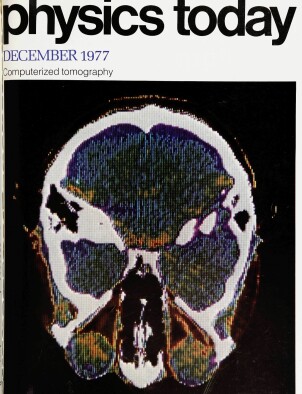Computerized tomography: taking sectional x rays
DOI: 10.1063/1.3037825
An important new diagnostic technique is making its appearance in our major hospitals. The technique, which uses x rays to render visible thin slices through any section of the human body, has been so dramatic in its development that no general agreement has yet been reached on its name—it has been called “computed tomography,” “computerized axial tomography,” “transaxial tomography” and “reconstruction from projections.” Figure 1 shows one version of the apparatus in a clinical setting.
This article is only available in PDF format
References
1. J. Radon, Ber. Verh. Sachs. Acad. Wiss. 69, 262 (1917).
2. A. M. Cormack, J. Appl. Phys. 34, 2908 (1964).https://doi.org/JAPIAU
3. D. E. Kuhl, R. Q. Edwards, Radiology 80, 653 (1963).https://doi.org/RADLAX
4. G. N. Hounsfield, Br. J. Radiol. 46, 1016 (1973).https://doi.org/BJRAAP
5. R. A. Brooks, G. DiChiro, Phys. Med. Biol. 21, 689 (1976).https://doi.org/PHMBA7
6. Proceedings of the 1975 Workshop on Reconstruction Tomography in Diagnostic Radiology and Nuclear Medicine (San Juan, Puerto Rico), University Park, Baltimore (1977).
7. Proceedings of the International Workshop on Techniques of Three‐Dimensional Reconstruction, BNL 20425 (E. B. Marr, ed.), Brookhaven National Laboratory, Upton, N.Y. (1976).
8. Technical Digest of the 1975 Optical Society of America Technical Meeting (Stanford University), OSA, Washington, DC.
9. R. Gordon, G. Herman, Intl. Rev. Cytol. 38, 111 (1976).
10. H. H. Barrett, S. K. Gordon, R. S. Hershel, Comput. Biol. Med. 6, 307 (1976).https://doi.org/CBMDAW
11. H. H. Barrett, W. Swindell, Proc. IEEE 65, 89 (1977).https://doi.org/IEEPAD
12. R. E. Alvarez, A. Macovski, Phys. Med. Biol. 21, 733 (1976).https://doi.org/PHMBA7
13. J. F. Greenleaf, S. A. Johnson, National Bureau of Standards Special Publication 453, Washington, DC (1976), page 109.
14. P. C. Lauterbur, in reference 8.
15. R. N. Bracewell, A. C. Riddle, Astrophys. J. 150, 427 (1967).https://doi.org/ASJOAB
16. D. W. Sweeney, C. M. Vest, Appl. Opt. 12, 2649 (1973).https://doi.org/APOPAI
17. Hal Clement, “Star Light,” Analog Sci. Fict. Sci. Fact 85, 55 (1970).
More about the Authors
William Swindell. University of Arizona, Tucson.
Harrison H. Barrett. University of Arizona, Tucson.




